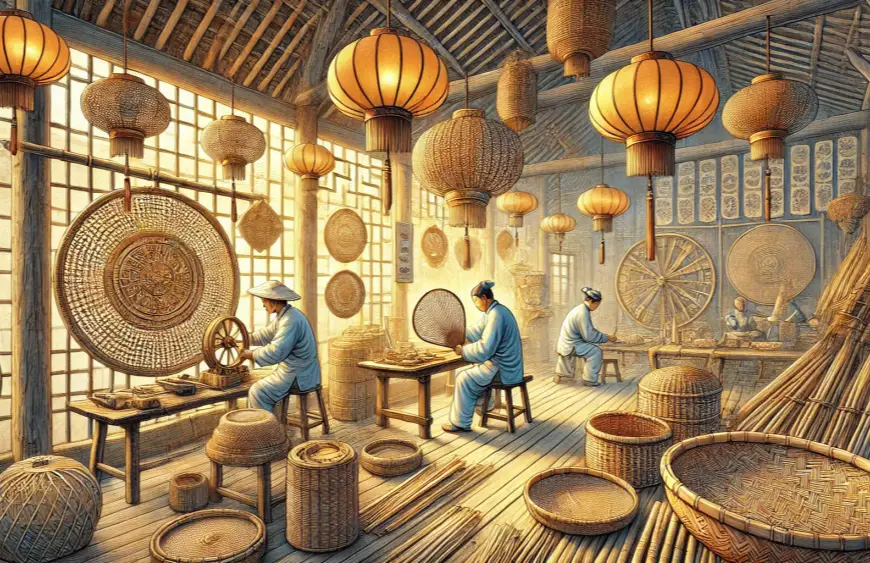A Timeless Chinese Treasure

The Millennia-Old Art of Bamboo Weaving: A Timeless Chinese Treasure
The Chinese have cherished bamboo for centuries, embedding it deeply into their culture and spirit.
Bamboo stands alongside pine and plum as the “Three Friends of Winter” and is one of the “Four Gentlemen” in Chinese floral symbolism, alongside plum, orchid, and chrysanthemum. Throughout history, poets and scholars have revered bamboo as a symbol of resilience, integrity, and grace.
The Song Dynasty poet Su Dongpo famously declared, “Better to have no meat than no bamboo. Without meat, one grows thin; without bamboo, one becomes vulgar.” To him, a life without bamboo was devoid of refinement and virtue. Similarly, Qing Dynasty artist Zheng Banqiao immortalized bamboo’s tenacity in his poem:
“Firmly rooted in rocky soil,
undaunted, it clings to the mountain.”
Beyond its poetic symbolism, bamboo also embodies the beauty of traditional Chinese craftsmanship, with bamboo weaving showcasing the harmonious blend of artistry and functionality.
Bamboo Weaving in Daily Life
Bamboo weaving transforms delicate bamboo strips into intricate creations through interlacing and binding techniques. These handcrafted items, ranging from baskets to tea implements, are not just functional but deeply connected to Chinese culture.
For example, the famed Song Dynasty tea scholar Cai Xiang wrote in The Record of Tea Utensils that bamboo woven baskets were used to store and roast tea leaves, ensuring optimal flavor and aroma. The packaging of An Tea, a specialty of Qimen, continues this tradition today. Over time, the tea absorbs the intertwined fragrances of bamboo, tea leaves, and sheath, creating a complex and lingering taste.
The Origins of Bamboo Weaving
The roots of bamboo weaving trace back to the Neolithic period, when early humans discovered bamboo’s durability and flexibility. Stone axes and knives were used to craft bamboo into baskets and containers for agriculture and hunting.
Interestingly, bamboo weaving even played a role in the creation of pottery. Ancient communities realized that bamboo baskets coated with clay became watertight when fired, inspiring the development of ceramics. This connection is evident in archaeological findings, such as the bamboo-patterned pottery from the Liangzhu Culture (circa 3300–2300 BCE) and the Banpo site (circa 5000–4500 BCE).
During the Shang and Zhou dynasties, bamboo weaving designs evolved, incorporating intricate patterns like grids, waves, and geometric shapes.
Bamboo Weaving from the Warring States to the Qing Dynasty
By the Warring States period, bamboo weaving had matured into an art form. Bamboo products such as mats, fans, baskets, and boxes were widely produced, with exquisite craftsmanship evident in archaeological finds.
One notable example is the Dao Fan (knife-shaped fan), a bamboo-woven fan with a trapezoidal shape. Long-handled versions symbolized status and were used by attendants, while smaller ones served as personal accessories for women. Fans unearthed from the tombs of this period reveal their detailed weaving and intricate patterns, embodying both utility and artistic flair.
During the Tang and Song dynasties, bamboo weaving became integral to festivals like the Lantern Festival. Artisans crafted bamboo frames for lanterns, which were adorned with paper or silk. Intricate designs, such as dragon-shaped lanterns, showcased the versatility of bamboo weaving.
In the Ming and Qing dynasties, bamboo weaving reached new heights. Items like bamboo-thread mats, celebrated for their smoothness and durability, became luxury goods. Bamboo weaving also merged with lacquerware techniques to create exquisite jewelry boxes and trays. By the Qing Dynasty, bamboo craftsmanship had become renowned as an “Eastern art form.”
Modern Bamboo Weaving: A Revival of Tradition
In the late 19th and early 20th centuries, bamboo weaving techniques were further refined, with over 150 weaving methods documented. However, the craft suffered a decline during wartime, only to be revived post-WWII.
In the 21st century, bamboo weaving has gained recognition as a national intangible cultural heritage. The process—from selecting bamboo to steaming, splitting, weaving, and shaping—remains a meticulous art form. Modern artisans continue to innovate while preserving the essence of this ancient craft, ensuring its legacy endures for future generations.
The art of bamboo weaving, spanning thousands of years, is more than just a craft; it is a testament to Chinese ingenuity and cultural heritage. From its humble beginnings in daily life to its elevation as a national treasure, bamboo weaving remains a radiant symbol of China’s enduring aesthetic and artisanal spirit.

